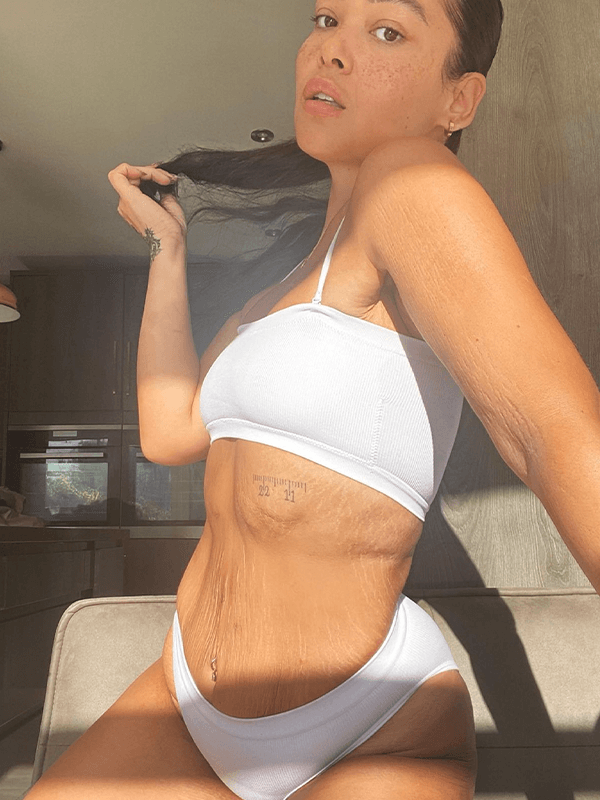Stretch marks can be a source of self-consciousness for many people. These marks, caused by rapid changes in body size or shape, can appear on various parts of the body, including the stomach, buttocks, and breasts. While there are several methods to hide stretch marks, one option that has gained popularity is using tattoos for cover-up. In this article, we will explore whether tattoos can effectively cover stretch marks and discuss the various procedures involved.
Table of Contents
ToggleCan Tattoos Really Cover Stretch Marks?
The good news is that tattoos can indeed cover stretch marks. Whether you want to completely conceal them or transform them into a beautiful piece of art, tattoos offer a legitimate solution. However, it is essential to select a professional tattoo artist who is experienced in working with stretch marks. By informing them ahead of time, they can work with you to create a design that effectively covers and blends with your stretch marks.
Tattooing on Loose Skin: Is It Possible?
Tattooing on loose or crepey skin can be challenging. Due to decreased collagen and elastin, loose skin is more difficult to tattoo and is prone to stretching and warping. However, skilled tattoo artists can still work with you to achieve satisfactory results. Consult with an experienced artist who can assess your skin and provide guidance on the best approach for tattooing over loose skin.
Stretch Mark Tattoo Procedures: Medical and Cosmetic
There are two main types of procedures for tattooing over stretch marks: medical and cosmetic. Let’s take a closer look at each.
Medical Tattoo Stretch Marks
Medical tattooing, also known as cosmetic micropigmentation or stretch mark camouflage, involves using permanent makeup to reduce the visibility of stretch marks. The process is similar to enhancing eyebrows, eyes, or lips with permanent cosmetics. Organic pigment is embedded into the stretch mark and the surrounding area to color-correct and blend the marks with the natural skin tone.
Cosmetic Tattoo Stretch Marks
Cosmetic tattoo procedures for stretch marks, also known as “inkless” tattoo stretch marks, involve micro-needling the skin. This process creates tiny holes that stimulate collagen and elastin production. Although no ink is used, the tattoo machine helps serums, oils, and vitamins penetrate deeper into the skin, resulting in improved texture. However, this procedure does not target color contrast caused by stretch marks. The treated area may appear red and inflamed for a few days but will gradually heal and fade over time.
If you prefer to highlight your stretch marks rather than conceal them, you can opt for a tattoo design that incorporates color, art, or even a small blackout tattoo. There is no right or wrong way to cover your stretch marks, and you may find that highlighting them actually makes them less noticeable.
Is Tattooing Over Stretch Marks Challenging?
Tattooing over stretch marks can present some unique challenges. The skin around stretch marks may be more tender and sensitive, resulting in increased pain during the tattooing process. Therefore, many tattoo artists recommend waiting until the stretch marks have settled and aged. Generally, older stretch marks are less sensitive, but it is important to note that pain levels may still vary.
Preparing for a Stretch Mark Tattoo
Preparing your skin for a stretch mark tattoo is crucial to ensure the best possible outcome. In the weeks leading up to your appointment, moisturize and hydrate your skin regularly. This helps make the skin more receptive to the tattooing process and facilitates navigation of the skin’s texture. However, on the day of your appointment, avoid applying moisturizer, as it may interfere with the stencil placement.
Frequently Asked Questions
Q: What should I do if I get more stretch marks where the tattoo is?
A: If new stretch marks appear in the tattooed area, they may alter the appearance of the tattoo. Depending on their size, they could either go unnoticed or significantly change the overall look. For this reason, it is advisable to postpone getting a tattoo if you are planning to become pregnant or anticipate significant changes in your body.
Q: Are there alternative solutions to tattooing for covering stretch marks?
A: Yes, there are non-invasive alternatives to tattooing for addressing stretch marks. One such solution is Dermaclara, a dermatologist-approved, chemical-free, and cost-efficient option. Using medical-grade silicone, Dermaclara boosts collagen, elastin, and moisture, resulting in the fading of stretch marks, wrinkles, and fine lines. With consistent use, you can achieve permanent results without the need for invasive procedures.
Conclusion
Tattoos can be an effective way to cover stretch marks, providing a personalized and artistic solution. Whether you choose medical tattooing or cosmetic procedures, consult with reputable tattoo artists who have experience working with stretch marks. Additionally, consider alternative options like Dermaclara for a non-invasive approach to addressing stretch marks. Remember, embracing your stretch marks is also a beautiful option, as they are a natural part of your journey and can be a symbol of growth and resilience.







